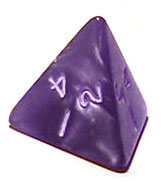Four-sided Die on:
[Wikipedia]
[Google]
[Amazon]
 Four-sided dice, abbreviated d4, are often used in
Four-sided dice, abbreviated d4, are often used in
 Four-sided dice, abbreviated d4, are often used in
Four-sided dice, abbreviated d4, are often used in tabletop role-playing game
A tabletop role-playing game (typically abbreviated as TRPG or TTRPG), also known as a pen-and-paper role-playing game, is a form of role-playing game (RPG) in which the participants describe their characters' actions through speech. Participa ...
s to obtain random integer
An integer is the number zero (), a positive natural number (, , , etc.) or a negative integer with a minus sign ( −1, −2, −3, etc.). The negative numbers are the additive inverses of the corresponding positive numbers. In the languag ...
s in the range 1–4. Three forms exist of this die: a tetrahedron
In geometry, a tetrahedron (plural: tetrahedra or tetrahedrons), also known as a triangular pyramid, is a polyhedron composed of four triangular faces, six straight edges, and four vertex corners. The tetrahedron is the simplest of all th ...
(pyramid shape) with four equilateral triangle
In geometry, an equilateral triangle is a triangle in which all three sides have the same length. In the familiar Euclidean geometry, an equilateral triangle is also equiangular; that is, all three internal angles are also congruent to each oth ...
-shaped faces, a rectangular prism with rounded or pointed ends, and an elongated long die with four triangular faces. The latter type does not roll well and is thus usually thrown into the air or shaken in a box.
Historical
Four-sided dice were among the gambling and divination tools used by early man who carved them from nuts, wood, stone, ivory and bone. Six-sided dice were invented later but four-sided dice continued to be popular in Russia. InAncient Rome
In modern historiography, ancient Rome refers to Roman civilisation from the founding of the city of Rome in the 8th century BC to the collapse of the Western Roman Empire in the 5th century AD. It encompasses the Roman Kingdom (753–509 BC ...
, elongated four-sided dice were called ''tali'' while the six-sided cubic dice were ''tesserae''. In India
India, officially the Republic of India (Hindi: ), is a country in South Asia. It is the seventh-largest country by area, the second-most populous country, and the most populous democracy in the world. Bounded by the Indian Ocean on the so ...
and Tibet
Tibet (; ''Böd''; ) is a region in East Asia, covering much of the Tibetan Plateau and spanning about . It is the traditional homeland of the Tibetan people. Also resident on the plateau are some other ethnic groups such as Monpa, Taman ...
, three four-sided long dice were rolled sequentially as an oracle, to produce 1 of 64 possible outcomes.
The ancient Mesopotamian Royal Game of Ur
The Royal Game of Ur is a two-player strategy race board game of the tables family that was first played in ancient Mesopotamia during the early third millennium BC. The game was popular across the Middle East among people of all social strata ...
uses eight four-sided pyramid-shaped dice made out of rock, half of them colored white, and half black. The Scandinavian game daldøs
Daldøs ø.html"_;"title="al'dø">al'døsis_a_Running-fight_game.html" ;"title="ø">al'døs.html" ;"title="ø.html" ;"title="al'dø">al'døs">ø.html" ;"title="al'dø">al'døsis a Running-fight game">running-fight board game only known from a f ...
uses a four-sided long die.
Modern gaming
Role-playing games involving four-sided tetrahedral dice include ''Dungeons & Dragons
''Dungeons & Dragons'' (commonly abbreviated as ''D&D'' or ''DnD'') is a fantasy tabletop role-playing game (RPG) originally designed by Gary Gygax and Dave Arneson. The game was first published in 1974 by Tactical Studies Rules, Inc. (TS ...
'', ''Ironclaw'', and ''Pathfinder Roleplaying Game
The ''Pathfinder Roleplaying Game'' is a fantasy role-playing game (RPG) that was published in 2009 by Paizo Publishing. The first edition extends and modifies the System Reference Document (SRD) based on the revised 3rd edition ''Dungeon ...
''. The d20 System includes a four-sided tetrahedral die among other dice with 6, 8, 10, 12 and 20 faces. Tetrahedral dice are peculiar in that there is no topmost face when a die comes to rest. There are several common ways of indicating the value rolled. On some tetrahedral dice, three numbers are shown on each face. The number rolled is indicated by the number shown upright at all three visible faces—either near the midpoints of the sides around the base or near the angles around the apex. Another configuration places only one number on each face, and the rolled number is taken from the downward face.
References
{{reflist Dice